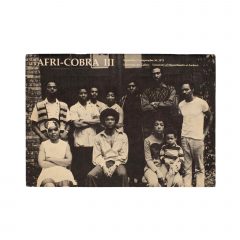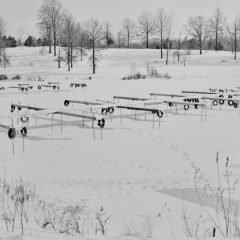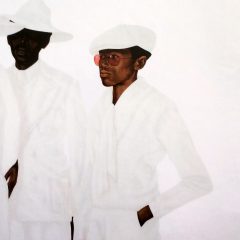“Are you lonely?” asks my British hostess during a dinner at her home in London. The question issues from a conversation about loss, death, and in some indirect way how loss eviscerates the landscape of the mind and heart and makes social networks and chance encounters both meaningful and empty. My hostess explains she’s suffering from the loss of a beloved parent. I know this feeling. “Am I lonely?” I repeat. Do I look lonely? I am planning on seeing the Exposed exhibition at the Tate Modern, so I was thinking about this question. So am I?
![Under An English Sky [Part lll] : Exposed At The Tate Modern & Anish Kapoor's Sky Mirrors In Kensington Gardens London 1 KoheiYoshiyuki 16 Untitled 1971 5757](https://www.theartblog.org/wp-content/uploaded/KoheiYoshiyuki_16_Untitled-1971-5757-300x199.jpg)
In an immense, multi-cultural cauldron like London with virtually no one on the streets knowing how to read the Tube map or help you find a street a block away, you are bound to find yourself mediating the gap between private and public worlds, or if you like, ruminating on being lonely. London, if you haven’t heard, has more surveillance cameras spying on its inhabitants and visitors than any other city on the planet. You can sing the melancholic “All By Myself” in a park and be viewed by paid observers, somewhere in the sky above London Town.
![Under An English Sky [Part lll] : Exposed At The Tate Modern & Anish Kapoor's Sky Mirrors In Kensington Gardens London 2 ky 1971](https://www.theartblog.org/wp-content/uploaded/ky-1971-300x198.jpg)
So the following day I take the Tube to the Tate Modern to see the highly-regarded (pun intended) “Exposed” exhibition. More than a dozen rooms, jam packed with visitors, cover the history of voyeurism, surveillance and the camera. Hundreds of works are neatly assembled with clear explanations outlining the surreptitious image-stealing activities in which we are all participants, each expressing the odd and obvious revelation that we are not alone. It’s troubling and, if you can believe it, thrilling. And, as you might expect, visitors are not allowed to take photographs in the Exposed exhibition. A kind of “so there” thing, no?
![Under An English Sky [Part lll] : Exposed At The Tate Modern & Anish Kapoor's Sky Mirrors In Kensington Gardens London 3 Walker Evans](https://www.theartblog.org/wp-content/uploaded/mia_17170b.fpxobjiip1.0wid640hei480rgn-0.086080590.01.172161101-300x225.jpg)
That said, there’s quite a lot to see here: Walker Evans captures sleepy, staring, often sullen subway riders with a camera in order to document the real. I remember that his was an age of grit and realism, and his works here indicate rather than radiate. But there is a quality to them that allows us to understand a bit more deeply how Evans (1903-1975), the great documentary photographer of the dust bowl and the Great Depression really worked, and what he was really after: the person behind the face, the face of poverty, the real. Yet his invasion of these passengers’ privacy set a low bar on what would soon happen as the photographic image took over newspapers, magazines and everything else.
Jacob Riis and Paul Strand, each in their own ways refined this art of portraying everyday people, probably shocking many in the same way Manet’s paintings blew apart the mannered tastes of mid-19th century Paris with their casual approach to portraiture – the unfinished canvases, the smudgy contours, and above all the common loiterers as subjects.
![Under An English Sky [Part lll] : Exposed At The Tate Modern & Anish Kapoor's Sky Mirrors In Kensington Gardens London 4 Henri Cartier-Bresson](https://www.theartblog.org/wp-content/uploaded/Behind-the-Gare-St.-Lazare-Paris-205x300.jpg)
Many great photographers soon appeared in the 1930s and 1940s, above all Henri Cartier-Bresson, the Frenchman who was so effective at grabbing the instant. Most people today probably believe his “decisive moment” – Behind the Gare St Lazare – is the most perfectly made candid photograph ever taken. Reams have been written about it, but Cartier-Bresson produced hundreds of these street scenes that are perfect in so many ways we wish (or at least I do) we were captured by him in some banal activity like riding a bike or carrying a tray of hot rolls up a stone staircase. Robert Frank, Harry Callahan, and Garry Winogrand fill out the greats from this era, and their works are diamonds of reality sleuthing.
![Under An English Sky [Part lll] : Exposed At The Tate Modern & Anish Kapoor's Sky Mirrors In Kensington Gardens London 5 Miroslav Tichy Camera](https://www.theartblog.org/wp-content/uploaded/Miroslav-Tichy-Camera.jpg)
A wonderful surprise is the work of Czech photographer Miroslav Tichy, who created junky-looking cameras to snatch images of people, mostly women, in his native Kyjov. His home-made cameras are sensational objects, and his works are nostalgic-looking images of women’s legs and bottoms, portraits of people unaware of his activity. An exhibition of his work also appeared in February at The International Center of Photography in New York (it ended in May, 2010). See the review in the New York Times here.
![Under An English Sky [Part lll] : Exposed At The Tate Modern & Anish Kapoor's Sky Mirrors In Kensington Gardens London 6 weegee marilyn monroe sm](https://www.theartblog.org/wp-content/uploaded/weegee_marilyn-monroe_sm-243x300.jpg)
Much of what passes for eye candy these days is clearly the celebrity snapshot. Lindsay Lohan caught in a club boozing it up, heading into jail (or coming out) is almost expected fare for newspapers, magazines and television. It’s a global obsession, and the appetite is ravenous. But a half a century ago, there was Weegee, the Johnny-on-spot image maker. Yes, there’s Marilyn Monroe (circa 1950) with her white pleated skirt blown skyward thanks to a subway air grate. While a good amount of his known work concerns crime scenes, Weegee also focused on everyday life: A fascinating image of his captures a cinema audience from above: We see a couple making out in the center of the frame. The unposed beauty of this innocent age is both romantic and to our contemporary eyes, unreal. Can we actually behave like this now that everyone has a camera on their cell phone? The exhibition wall literature makes it clear that a faster camera shutter allowed photographers to steal these fleeting moments before they were folded into the past.
![Under An English Sky [Part lll] : Exposed At The Tate Modern & Anish Kapoor's Sky Mirrors In Kensington Gardens London 7 weegee audience palace theater sm](https://www.theartblog.org/wp-content/uploaded/weegee-audience-palace-theater_sm-300x238.jpg)
The exhibition covers an enormous amount of ground from Nan Goldin’s famous slide show of her battered and drug-addled friends, The Ballad of Sexual Dependency (1966), to Kohei Yoshiyuki’s astonishing series, The Park. And it’s with The Park I’ll meander a bit.
During a period in the 1970s (1971-1979), Yoshiyuki wandered Tokyo’s Aoyama, Shinjuku and Yoyogi parks at night, following veritable peeping Toms watching couples involved in secretive sexual encounters. Turns out, the trysts on the grass were not very secret. Yoshiyuki captures the hordes as they group and descend on their hands and knees to get extremely close to these lovers, sometimes even touching them. The photographer who behaved as if he were one of the peepers stands back a bit and takes photo after photo revealing a layering of voyeurism rarely observed. The Park became wildly famous and its place at Exposed is truly phenomenal for its depiction of desire and desperation. The images are clear enough to fully understand what’s happening, but the faces are hidden.
![Under An English Sky [Part lll] : Exposed At The Tate Modern & Anish Kapoor's Sky Mirrors In Kensington Gardens London 8 Kohei Yoshiyuki](https://www.theartblog.org/wp-content/uploaded/Kohei-Yoshiyuki-300x200.jpg)
The photographer stopped taking these photos in 1973, but returned to the series in 1979. He exhibited them that year at Tokyo’s Komai Gallery as life-sized prints; lights were turned off, and visitors were given flashlights to view the works, an effort to recreate the scene as Yoshiyuki had experienced it– as a voyeur. One should note that, according to the New York Times, the photographer “seemed to lose his nerve” and destroyed the prints. It was only in 2007 that New York gallerist Yossi Milo brought the work back to the public’s attention.
One is reminded in The Park works that many things go on in our world we have nary a hint of…and that is why Exposed yields so much, taking the observable, restating the obvious, and making a high art form out of it even in a world where every 12-year old has a camera attached to his or her phone. See more from this NYT piece.
My theory: We are all exposed, and we are all voyeurs, spying non-stop on all sorts of things we’re somewhat invited to see and other events that are strictly verboten. But we steal these images, the close ups, as we machete our way through reality. Taking a picture, though, and making it our own, is addictive, and a minor source of guilt. It is evidence, or better living proof, the actual trace of another reality not our own. Spying on someone has never been a nice thing to do. Ever catch your sibling or grandmother on the toilet? Or your significant other in bed with someone besides yourself? Or see you and your lover via Las Vegas-style love mirror mounted on the ceiling of your heart-shaped honey-moon suite? (Me, neither). Rubber-necking at a traffic accident, or even staring at the photos of jumpers at the World Trade Center attack on September 11? Or worse, a photo of you staring at the jumpers. It’s all a form of dread, is it not? That toxic cocktail of attraction + repulsion. Then it passes.
Exposed is an exhibition that is more necessary than gratuitous. The show is a high-end distillation of the voracious visual animals and consumers we’ve become, historically unpacking our fascination with the other. Seeing what we see is what we need museums for, and this exhibition lays out our guilty pleasures at seeing ourselves unaware. Candid camera! The world revealed and yet still unknowable.
![Under An English Sky [Part lll] : Exposed At The Tate Modern & Anish Kapoor's Sky Mirrors In Kensington Gardens London 9 photo](https://www.theartblog.org/wp-content/uploaded/photo-225x300.jpg)
Anish Kapoor: Turning The World Upside Down
Finally, to really do justice to the English sky business, Anish Kapoor, offers up his discs and mirrors that reflect the gardens, trees and yes, the sky with four installations in Kensington Gardens – Turning The World Upside Down.
During an early morning walk in October, I come upon Sky Mirror, Red, 2007, a gorgeous polished stainless steel mirror tinted red and situated in the Queen’s lake. Swans swim around this enormous disk (2.74 m x 2.9 m) as its concave eye captures the shifting sky through a red filter or tint. A guard stands nearby to make sure no one swims out to the piece, or tosses sausages at it (I didn’t). It’s quite beautiful and silent and smart in the way Kapoor’s work can be: reflective and introspective in a multi-metaphoric fashion. And there is the beautiful sky, looking somewhat Martian-like, on this wonderful morning.
![Under An English Sky [Part lll] : Exposed At The Tate Modern & Anish Kapoor's Sky Mirrors In Kensington Gardens London 10 kapoor1](https://www.theartblog.org/wp-content/uploaded/kapoor1-225x300.jpg)
Further on, one comes across Non-object (Spire), also from 2007, a stainless steel cone, polished to a brilliance one sees only in quicksilver (mercury) and that when approached reflects only itself and the trees around it. Another guard here cautions me not to fall on the piece (I don’t). I consider the interest in this work for geometry students on a field trip, trying to figure out the exact nature of this million dollar object. It’s a wonderful sculpture to find in a park as big and green as Kensington Gardens. Like us, walking alone considering the nature of the universe (and ourselves), Kapoor’s work seems to be busy doing the same.
Another Sky Mirror from 2006 and five times as large as the red work, is positioned directly opposite the red piece, nearly a quarter mile away; as I walk towards the exit, workmen are installing and polishing C-Curve from 2007 (302 x 300 x 300 cm). The piece is comprised of a large curved hunk of steel that sits on a low lying plinth; my guess is you can walk up to it and touch your image, if the guards allow you. At the very least, you can see yourself expanded and distorted, your image brilliantly thrown back at you : a fun house mirror with an inside and outside, a pristine Richard Serra work without the rust or the overly masculine overtone. (See photographs of the installed pieces, courtesy of DesignBoom).
My fear is that the hundreds of dogs who have free run of Kensington might have a go at this piece. Dogs, from my experience, don’t have much use for contemporary art. And they don’t really care, do they, if they are exposed or not, photographed or ignored.
Exposed: Voyeurism, Surveillance and the Camera
Tate Modern 28 May – 3 October 2010
Tate Modern Exposed Website
Anish Kapoor: Turning The World Upside Down
Kensington Gardens, London
September 28th, 2010 to march 13th, 2011
Matthew Rose is an American artist based in Paris, France. His current exhibition of collage works and terribly unusual objects, Scared But Fresh at The Orange Dot Gallery in London, runs through October 31, 2010.









